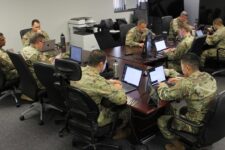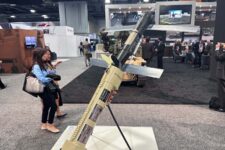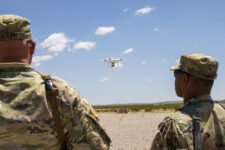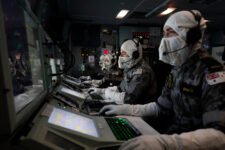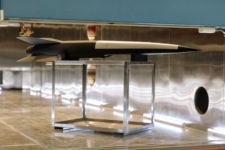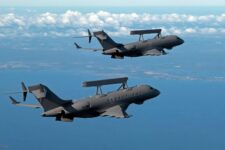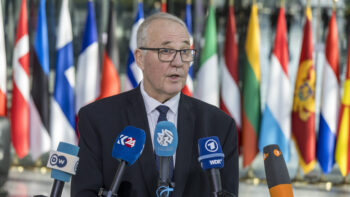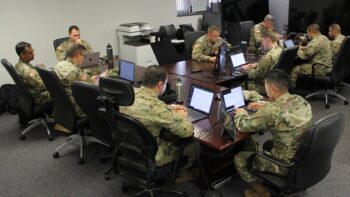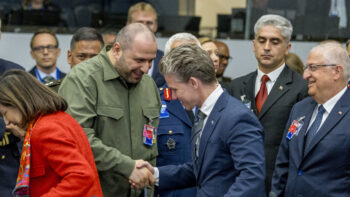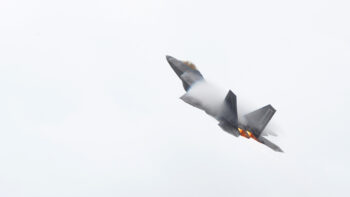
Gen. Stephen Lyons, TRANSCOM commander
WASHINGTON: America’s new way of war, soon to be articulated in the Joint Warfighting Concept, will require more and different intra-theater lift capabilities, says the outgoing head of Transportation Command.
“What we see, as we look to the future, is actually some increasing demands on the logistics enterprise, and specifically with regard to intra-theater transport, whether that be surface oriented with more shallow-draft kinds of vessels or air mobility,” Gen. Stephen Lyons told the Hudson Institute.
“That’s an area we’re still exploring, because many of the concepts in the force design work are still in development,” he added. “The logistics aspects of that — the mathematical aspects or the calculus — that will follow based on the concept and based on the force design work that comes out of that, but we certainly see increasing demands.”
He explained that the JWC’s direction leads planners “to envision much smaller force elements that are inherently reliant on very rapid mobility — rapid mobility to move the force element into position or relocate it, and rapid mobility to be able to rearm or refuel, or reconstitute that force element to continue to operate.”
Lyons further noted that “autonomy is absolutely part of all of our future weapon systems,” and not just for TRANSCOM’s own missions. While he said there likely will be “cultural or policy or legal obstacles” to getting there, but “unmanned aircraft in all aspects are certainly part of the part of the future.”
Thus, TRANSCOM will need to “relook some of our force structure,” he explained, and assess “how that drives broad logistics costs.”
The Joint Warfighting Concept will outline the new American way of war known as All Domain Operations; that is, next-generation, information-based wars using enormous amounts of AI-driven analysis across the five “domains” of land, air, sea, space and cyberspace. The services were tasked by Chairman of the Joint Chiefs of Staff Gen. Mark Milley with fleshing out the JWC sub-concepts: the Army has contested logistics; the Air Force Joint All Domain Command and Control (JADC2); and the Navy joint, long-range fires. The Joint Staff was tasked to define information advantage, as none of the services volunteered to take on that difficult challenge.
Launched in 2019 by then-Defense Secretary Mark Esper, a draft of the new warfighting concept and detailed articulations of its four sub-concepts were originally slated for completion by the end of 2020. After a delay caused by the COVID-19 pandemic, it now is expected to be blessed by Milley and Defense Secretary Lloyd Austin with weeks if not days.
Lyons said that a key to future rapid mobility will be better use of data.
“As we move forward, I think there’s great promise in the area of data,” he said. Using artificial intelligence and machine learning, TRANSCOM is trying “to really leverage the data in a better way to enable decision-making, not just in a headquarters like this but at echelon, to ensure we can improve weapon systems availability — ensure that we can deliver the right force elements at the right time to create the right outcomes for a geographic Combatant Commander.”
The Need for “Liquid Energy”
Lyons praised the Tanker Security Program passed by Congress last year as part of the 2020 National Defense Authorization Act, which creation of a 10-ship Tanker Security Fleet, modeled after the Maritime Security Program (MSP), to provide a stipend to shipowners who make their militarily useful tankers available in times of war or national emergency.
“I’m a big advocate,” he said. “I appreciate the work that the staffers have done up on the Hill. Our analysis says very similar things — that we have to move in that direction, to ensure that we have access to US flag assets in a time of crisis.”
While Lyons acknowledged that there are plenty of tanker ships operating around the world, he stressed that the US needs US-flagged vessels that are ready at a moment’s notice to provide precious “liquid energy” to the military. “We have to have a policy of assured access in a time of crisis, and we’re working through that. “I think the first step is this Tanker Security Program and the authorization that came through.”

SpaceX’s Starship already is being eyed by TRANSCOM for point-to-point transport.
In addition, he said, the US military has to fundamentally re-think how it does logistics, especially fuel supply, in the face of global threats from peer competitors. “We acknowledge that the way we posture today — you know, with large, fixed and somewhat vulnerable facilities — will not accommodate a future contested environment,” he said.
The military needs to move “to a very dynamic and resilient system of multiple supply points, multiple distribution platforms, and a command and control apparatus to ensure that we can allocate this scarce resource to the highest priorities,” he said. This is a critical issue not just for the maritime fleet, he stressed, but also for “all the other consumers out there in the air and ground space.”
So perhaps it’s not surprising that Lyons waxed enthusiastic about the promise of “space mobility” — that is, using rockets to transport cargo and perhaps even people from one side of the planet to the other in minutes — to enable “multi-domain logistics.” While caveating that space lift won’t ever scale up to the equal of airlift in terms of sheer carrying capacity, Lyons said the speed at which space transport could happen — as well as “the ability to bypass some of the diplomatic alignment issues that we get tripped up with from time to time” — make its potential more than worth looking at.
TRANSCOM last year linked a non-monetary agreement with SpaceX to study the feasibility of cargo delivery via the company’s Starship spacecraft being developed to carry crew to the Moon and Mars for NASA.
“I am impressed at how fast some of these companies are moving in the commercial space to be able to go point-to-point on the Earth’s surface with cargo or perhaps a small force element,” Lyons said. “I think space mobility is right around the corner.”
Lyons also addressed Air Force plans to cut legacy aircraft to fund its modernization plans. While “there is still a lot of work to be done” to get Boeing’s troubled KC-46 tanker aircraft fully up to speed, he’s been “impressed” with the progress the program has made over the past year. It is that progress, he explained, that has led TRANSCOM to shift from its opposition last year to Air Force plans to retire legacy KC-10 and KC-135 tankers to supporting the service’s plans this year for aircraft retirement.
“I I do agree with the Air Force that it is time to begin some of the divestitures of the KC-135s to free up resources and manpower to focus on the future, which is clearly the KC 46,” Lyons said. “So, we’re in a different place this year than we were last year.”
